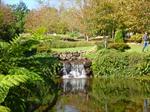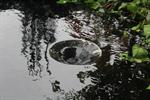WINTER WATER GARDENS
 Water gardens are something that can be appreciated over winter just as much as over summer. Whether from inside the house, or whilst taking a stroll in your winter warmers, water has infinite appeal.
Water gardens are something that can be appreciated over winter just as much as over summer. Whether from inside the house, or whilst taking a stroll in your winter warmers, water has infinite appeal.
Movement
You can still hear the splashing of water in winter…even if you don’t go outside as much. Moving water takes on a new meaning in winter. It blends with the sound of the wind whistling through the trees and the sight of loose leaves being tossed around the garden.
Stillness
Most of you would have experienced one of those fresh, crisp, still, winter’s days. As many of your plants remain dormant, and the insect count diminishes, it is a perfect time to observe the reflections on the pond’s surface. Position a seat so that you can admire the view. Think about how you might alter the landscape around the pond in order to change the reflected image.
Freezing
Frost, sleet and snow around the water’s edge can create a very different and extremely picturesque image, compared to the same water’s edge at other times of the year. Deciduous trees and shrubs close to a pond’s edge look fantastic when their branches are speckled with snow. They also provide beautiful reflections on the water’s surface. Large pebbles and stones can resemble a glacial landscape.
 IMPORTANT! Care should be taken in winter not to allow water features in the garden to overflow, particularly where water seeps onto a pathway. It only takes a small amount of water to freeze on a path to make it hazardous. Keep some grit to hand in case of emergency…it’s easily cleared up once temperatures rise.
IMPORTANT! Care should be taken in winter not to allow water features in the garden to overflow, particularly where water seeps onto a pathway. It only takes a small amount of water to freeze on a path to make it hazardous. Keep some grit to hand in case of emergency…it’s easily cleared up once temperatures rise.
In temperate climates during severe cold snaps, small water features and ponds will freeze over completely. Where this is likely, submerged pumps and filters should be disconnected. This is also a great time to maintain them.Wildlife
The water can attract bird-life, and other visitors over winter. Even though it’s not as hot, birds still have to drink!
Some types of fish will not survive in a freezing cold pond, whereas others will. You will need to check if yours will. You can prevent the water freezing over entirely by floating an upturned plastic bottle on the surface. Frogs and newts are usually happy at this time of year as they are hibernating in the depths of the pond or under rocks and plants.

Edging Plants
Deciduous trees, like willows, planted by water will lose their leaves. Some other plants, including water plants will change colour as their foliage dies back. Some, like hostas, alchemilla and acanthus will die down completely. By carefully considering how your plants will look during the midst of winter you can plan your winter water garden scene.
If you want to include colour then look at winter flowering annuals such as primulas, winter pansies, cineraria and cyclamen. Crocuses and snowdrops are great bulbs for setting the late winter scene around the pond.
Water Plants
Most of your water plants will be fine in your pond over winter, unless you have varieties from a different climate zone. Tropical water lilies come in many varieties, a number of which will survive even the harshest of Australian winters, although most of them flourish better in the subtropical north of Australia. Some varieties will need to be lifted out of the pond if the temperature falls below 12 degrees C, and stored in a mouse-proof container until spring. If at all concerned choose a hardy water lily instead.